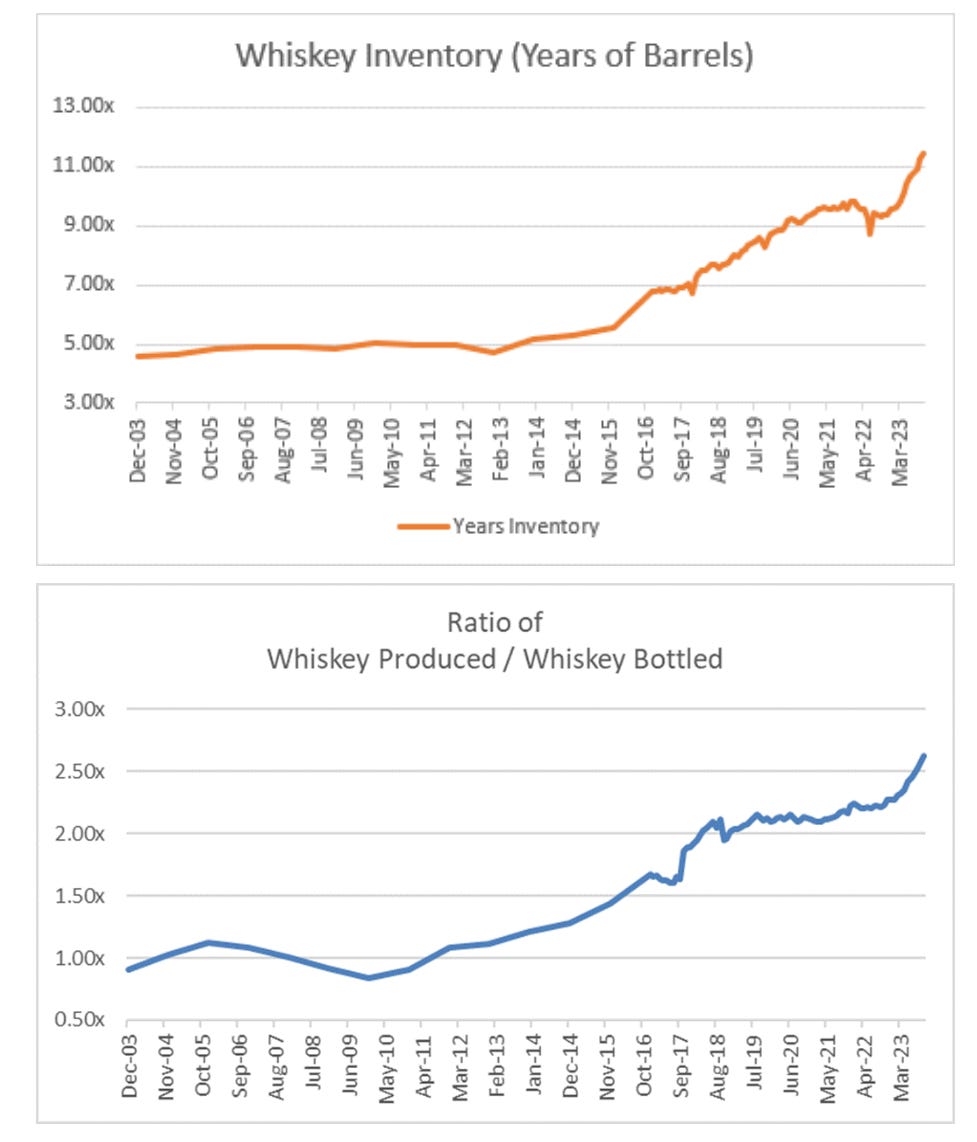Another Short Position — MGPI
An attractive way to short American whiskey prices
In this newsletter, I share summaries of attractive investment ideas sourced from the Value Investors Club and incorporated into my personal portfolio. These summaries will be complemented by regular updates on key developments impacting investment theses. My aim with Idea Hive is to document my portfolio management process while also enabling readers to quickly grasp and follow attractive investment opportunities.
In this post, I am back with another ‘short’ portfolio position: MGP Ingredients (MGPI). The idea was pitched on VIC back in February. You can read the full write-up here. The stock is currently trading in line with the write-up levels with no new material developments, so the setup is as attractive and actionable as at the time of the initial pitch.
Short Idea: MGP Ingredients (MGPI)
Elevator Pitch: An interesting way to short American whiskey prices as the industry comes off an epic supercycle.
Current Price: $78.61
Target Price: $12.40
MGP Ingredients is a $1.7bn market cap company that distills spirits, primarily American whiskey. The company's key profit driver is manufacturing and selling American whiskey barrels to other companies that bottle, brand, and sell the whiskey.
MGPI presents an interesting way to bet on the decline in American whiskey prices as the industry has been coming off a historic supercycle. During the 2010s, increasing American whiskey barrel prices, driven by accelerating demand, prompted a resounding supply response, with large industry players expanding existing and building new distilleries. This resulted in American whiskey inventories jumping to 8.7 years of demand as of 2019, compared to a normalized level of about 5 years. Meanwhile, whiskey put in barrels (i.e., a proxy for current supply) was more than twice the amount of whiskey bottled (a proxy for current demand) at the time.
The industry supercycle was further boosted by COVID, which led to higher whiskey demand at retail, driving a demand shock. This prompted another supply increase from American whiskey industry players, which brought on additional distillation capacity. These dynamics have driven American whiskey supply and production to unprecedented levels over recent years (see charts below).
As of October 2023, US inventories in barrels equal 11.4 years of demand. With the market already grossly oversupplied, production continues to outstrip demand, with the ratio of supply additions to demand at an all-time high of 2.63x as of October 2023 compared to 1x needed for inventories to stabilize.
It seems the market might have already inflected as American whiskey prices declined in the second half of 2023. Brown-Forman (producer of Jack Daniels) reported falling whiskey sales during several recent quarters, noting normalizing consumer demand after several years of above-historical trend growth (see quote from December 2023 conference call below). Another interesting aspect is the recent report on Heaven Hill, one of the largest bourbon producers in the US, laying off workers due to softer whiskey demand.
However, over the last couple of months, we have seen a slowdown in consumer spending similar to the trends we're seeing across total distilled spirits and other consumer packaged goods. After 2 years of strong growth, which was above our long-term historical trends, consumer demand for our brands is normalizing on this elevated base.
There seems to be plenty of room for a downward share price re-rating given that MGPI currently trades substantially above its replacement cost. The company's EV is currently at $2bn compared to $15m for which the company acquired its primary asset, a distillery in Indiana, back in 2011. While there is likely to be additional value in MGPI given incremental capex, inventories, and the company’s other assets, this seems to be a directionally correct estimate of replacement cost. Another way to triangulate it is to use MGPI’s most recently reported tangible book value of $273m or $12.40/share. A potential re-rating to this level, still above where MGPI traded before the industry upcycle, would imply a potential upside of 80%+.
Why does the opportunity exist? The key explanation is that analysts and investors appear to be focused on inventories at the distributor and retail level (i.e., in bottles) as opposed to the inventory of whiskey sitting in barrels.
So, this is the investment thesis in a nutshell. What follows is an overview of several points of pushback, although they do not seem likely to derail the investment thesis.
One explanation for the significantly increased barrel inventory might be premiumization, a trend whereby demand for higher-quality, longer-aged bottles increases at the expense of cheaper, less-aged whiskey. Industry data suggests that the volume share of super premium-tier has increased from 5% in 2010 to 18% in 2023. During a recent conference call, Brown-Forman highlighted this, underlining that premiumization has not been driven by COVID (see quote below). However, the impact of a growing share of premium-tier whiskey in the market on average aging times is likely to be marginal. As highlighted by the author of the VIC write-up, assuming that super-premium whiskey is aged for 10 years and that the share of super premium-tier whiskey increases to 25%, the average required aging time would only increase from 4.3 to 5.5 years, still significantly below the current inventory levels.
Well, I mean, I think the premiumization trend is not just a COVID thing. I mean it certainly put it on a rocket ship a little bit, but the premiumization trends have been happening for 10 and 20 years in the spirits business.
MGPI’s current operational performance is largely backward-looking and there’s a lack of visibility into MGPI’s forward contract/order terms. Another uncertainty is that if a significant portion of the company’s current contracts are long-term, there could be a delay until any whiskey price changes are reflected in the company’s financials.


